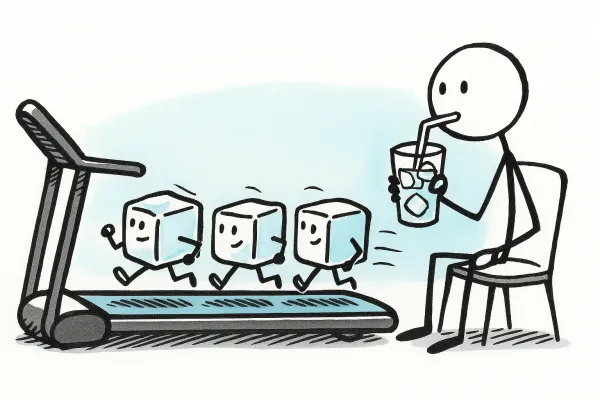How to Make Cow’s Milk Vegetarian (Yes, Seriously)
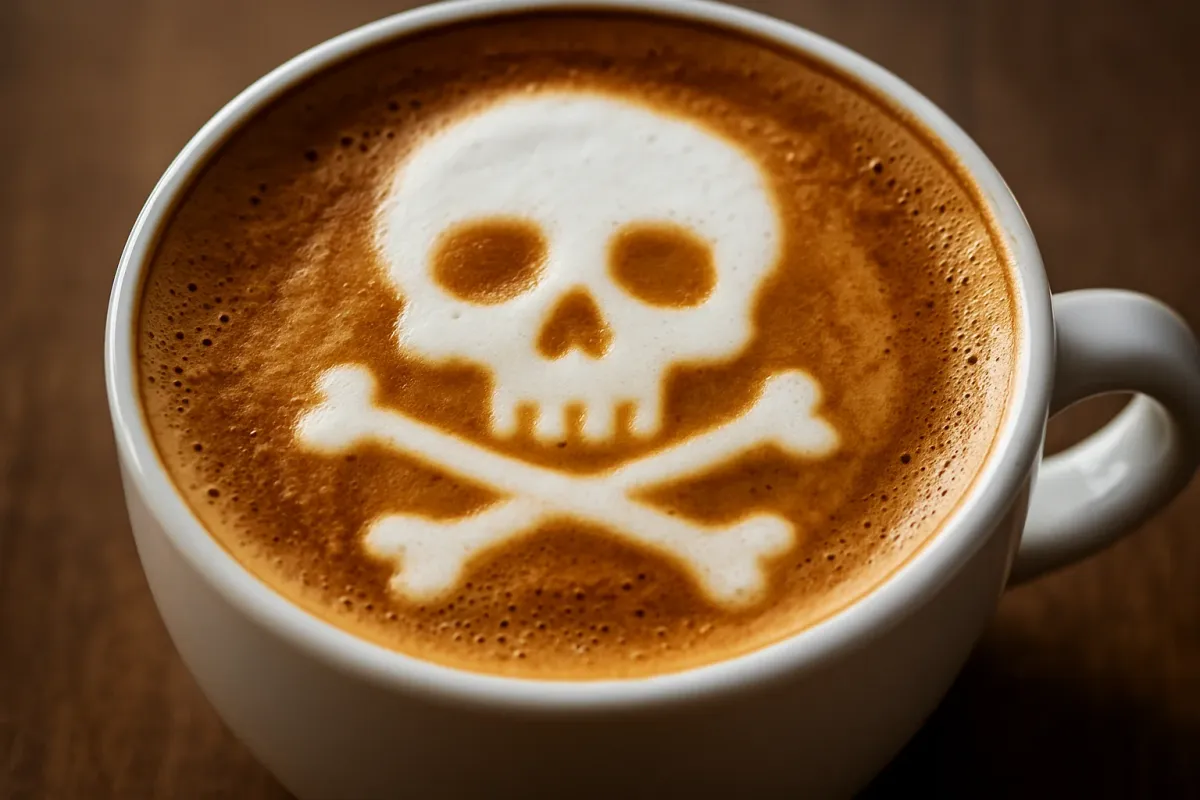
Imagine you’re sipping a cappuccino.
It’s foamy. It’s hot. It’s got just the right bitterness-to-smoothness ratio.
But as your lip touches the milk foam, a small voice inside your brain goes:
“This milk came from a cow. That cow had to be pregnant to make this milk. That means there was a calf. And the calf probably isn’t doing great right now. And also—wait—does this mean milk isn’t vegetarian?!”
Yep.
Welcome to the existential crisis you didn’t know was hiding in your coffee.
🐄 Wait, Milk Isn’t Vegetarian?
Let’s clarify. Milk doesn’t contain meat, so yes, it's vegetarian in the supermarket labeling sense. But the way conventional dairy works involves a quiet little truth bomb:
To make milk, cows have to give birth. Constantly.[1]
Like... once a year. On schedule. Like a car getting its oil changed.[1:1]
And every time a cow gives birth, there's a baby involved. If it’s a female calf, it might get raised into another milk machine. If it’s a male calf, well… it’s usually not great. Male dairy calves are often seen as biological byproducts—economically worthless. Many are slaughtered young or sold into low-welfare veal production. Some don’t live past a few days.[2]
And that’s the part that keeps a surprising number of vegetarians up at night.
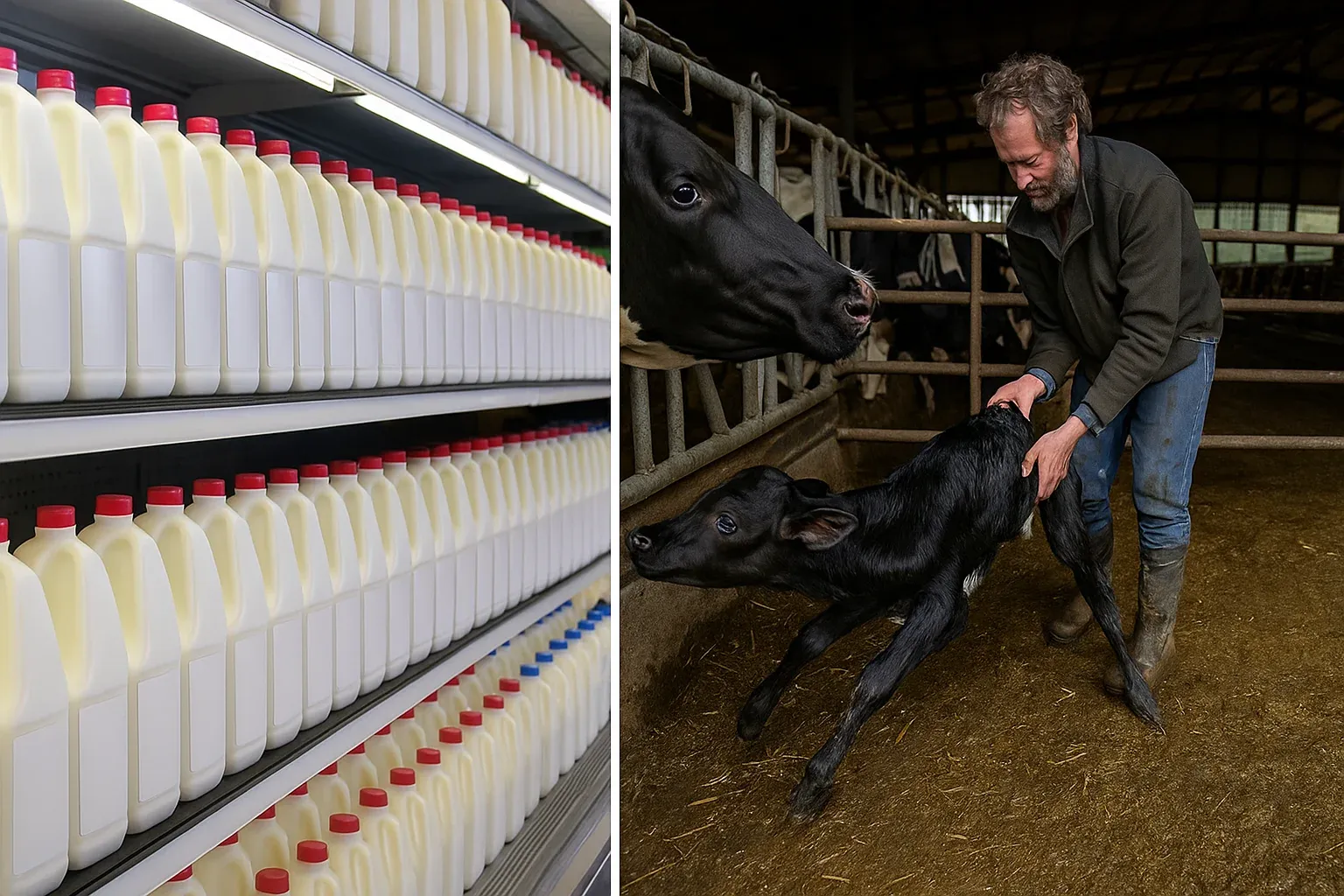
☠️ Fun Fact: Eggs Beat Milk in the Ethics Olympics
A few years ago, egg producers started eliminating the mass culling of male chicks. That used to be standard practice because male chicks don’t lay eggs (useless) and don’t grow fast enough to be broilers (double useless). So they were... deleted.
Cue global outrage.
The solution? In-ovo sexing: a literal chicken gender reveal party inside the egg. Farms now scan or test eggs before they hatch, and if it's a male, they don't incubate it. No baby chick is born, and the whole ethical problem goes poof.[3][4]
The dairy equivalent would be figuring out how to make milk without creating calves that have to die.
So the big question is:
Could we make milk that’s actually vegetarian—by design?
Surprisingly, the answer is maybe. And it starts with a cow that only gives birth once.
💡 The One-Calf Wonder: A Hypothetical Holy Cow
Imagine a world where a cow gives birth once, starts making milk… and just keeps making milk forever. Like a biological vending machine, just humbly producing 15–20 liters a day without ever needing to get knocked up again.
No more forced pregnancies. No more surplus calves. No more uncomfortable conversations between your oat-milk-evangelist friend and your latte.
Sounds dreamy, right?
But is it possible?
Kind of.
But first, we need to talk about how cow milk works (yes, biologically).
🧬 How a Cow’s Body Makes Milk (Or: Udderly Complex Hormones)
Milk production in mammals—including humans—is triggered by birth. Hormones like prolactin and oxytocin kick into high gear, telling the udder: Hey, you have a baby! Get milking!
Now, here’s the trick: you can keep the milk flowing as long as the udder keeps getting stimulated—via suckling or milking. That’s why dairy cows are milked 2–3 times a day.
But there's a catch.
After a while—usually around 10 to 12 months—the cow’s body starts to go:
"No more babies? Okay, we’re done here."
And milk production slows. Sometimes dramatically.[1:2]
Yet, there are legendary cows out there—real-life bovine unicorns—who’ve been milked for 20 months and beyond without calving again. These super-lactators are rare, but they prove that long, pregnancy-free milking is biologically possible.[5]
We just haven't designed our dairy systems to take advantage of that.
🗪 Could We Breed the Forever-Milking Cow?
Here’s where it gets sci-fi.
Modern dairy cows are the result of decades of selective breeding. The average dairy cow today produces several times more milk than a century ago (about fivefold in the U.S.).[6]
So what if we started selecting for lactation duration instead of just yield?
Turns out, scientists have already thought about this. There’s a trait called lactation persistency—basically, how long a cow keeps making milk without her yield dropping off a cliff. This trait is heritable, which means we could breed for it.[7][8][9]
Think of it like selecting dogs not just for bark loudness, but for how long they can bark before stopping. (Don’t do this, by the way.)
Geneticists already model entire lactation curves in breeding programs, so with some tweaks, we could shift the focus to flatter curves—cows that just keep giving steady milk day after day, month after month, maybe even years.[7:1]
One day, you might meet the iPhone 37 of cows: ultra-smooth, low-peak, long-lasting milk output.
But before you go buying cow NFTs, there’s a plot twist.
⚠️ The Big Biological Wall: Why “Forever” Isn’t Forever
Unfortunately, cows aren’t biological vending machines. They get tired. Hormones fade. Udders lose steam. Even the most persistent lactators eventually need a break.
The practical ceiling today is somewhere around 16 to 20 months of continuous milk after one calving, assuming great feeding and frequent milking.[5:1][1:3]
So no, we can’t (yet) build a cow that gives milk for life after one calf.
But…
Could we design a system where cows give birth only a few times in their life and still produce enough milk to feed us?
Could we reduce the number of unwanted calves?
Could we keep those calves alive—and even raise the males—for something more ethical than early slaughter?
Now you’re asking the right questions.
And that’s where things get interesting. Because it turns out, some people are already doing it.
🐮 The Ethical Dairy: Milk from the One-Calf Cow
Meet your average One-Calf Cow. Let’s call her Milda.
Milda lives in a new kind of dairy system—one that’s been designed to minimize suffering and maximize cow-ness, even if it breaks a few traditions (and accounting spreadsheets) along the way.
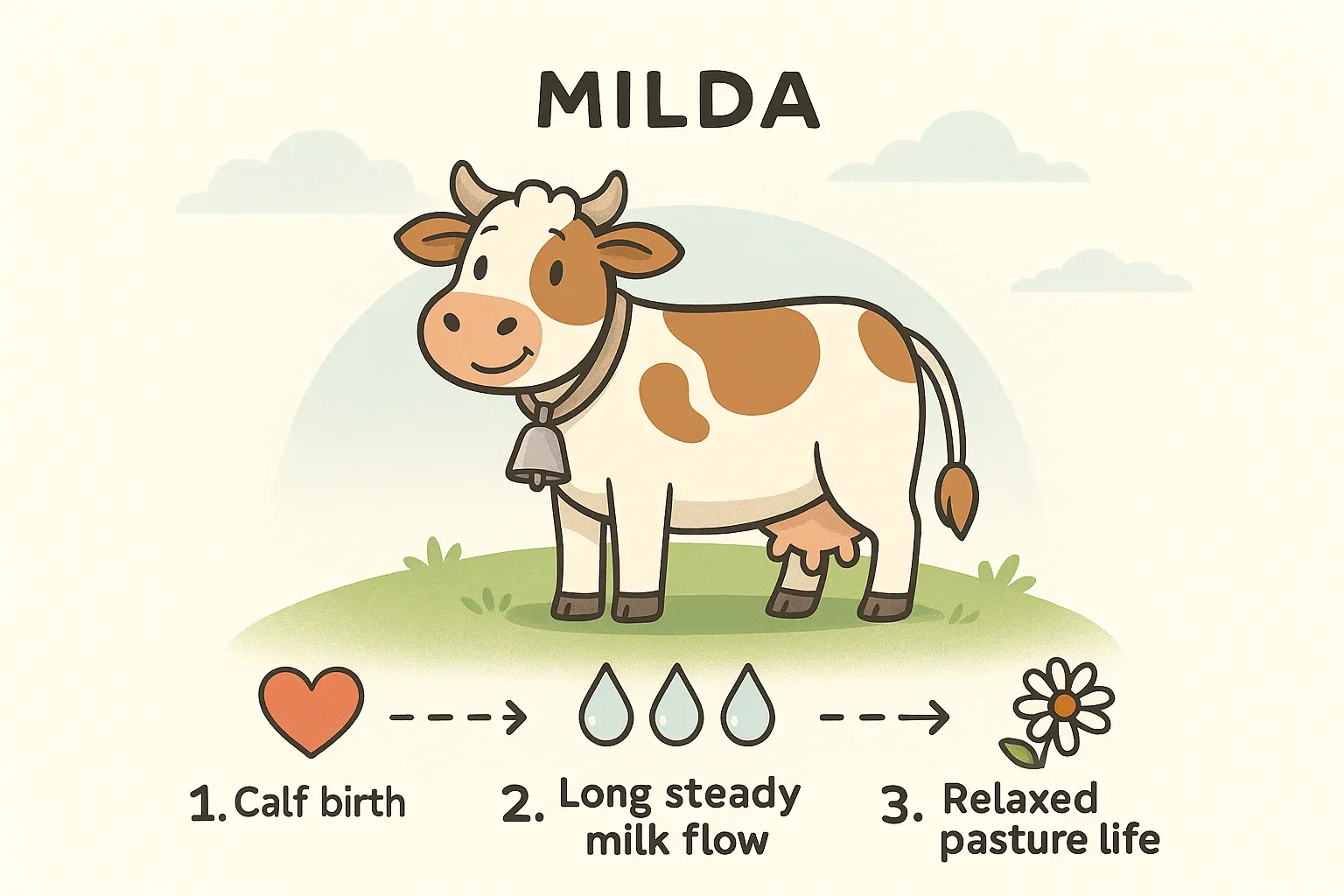
Here’s how her life goes:
🔬 Step 1: Born to Be Mild (But Genetically Persistent)
Milda was born to a cow selected not just for high milk yield, but for lactation persistency—the ability to keep producing milk steadily for well over a year, without needing another pregnancy. Her DNA has been handpicked (by genomics nerds with spreadsheets and AI tools) to give her a flat, stable lactation curve. Not too peaky, not too short. Just steady, like a solar panel in cow form.[7:2][8:1]
She won’t break milk yield records—but she’ll quietly outperform over time, like the Prius of cows.
👶 Step 2: One and Done
At around two years old, Milda has her one and only calf.
That calf? Gets to stay with her.
Not for an hour. Not a day. For months. Maybe until natural weaning. Milda is not milked aggressively during this period—her milk goes to her baby, just like in nature. And then…
When the calf is ready, it’s gently weaned. No screaming separation. No frantic pacing. Just… emotional closure.
It’s almost wholesome.
♉️ Step 3: What Happens to the Male Calves?
Here’s the big twist.
We don’t kill them.
Instead, farms in this model do one of three things:
- Raise them for ethical beef (grass-fed, slow-grown, low-impact).
- Use them as oxen for work, or in rare cases, sanctuary animals.
- Offer sponsorships—where people pay to “adopt” and support a bull’s care.
This is real: farms like the Ahimsa Dairy Foundation (UK) and Gita Nagari Creamery (US) do exactly this. Their milk is marketed as no-kill, and the bulls become pasture pets—or very large lawnmowers.[10][11]
🌾 Step 4: Milking Without Madness
After the calf is weaned, Milda is milked gently and regularly. Not pushed to extremes. No 40-liter-a-day monster yields. Just a modest 15–20 liters a day—sustainable, manageable, and physically safer.
Her udder health is monitored. Her body condition is kept in check. She gets time off. She grazes in open pastures. She hangs out with her cow friends like it’s a bovine retirement village with light duties.
And here’s the kicker:
She never has to get pregnant again.
Unless, maybe, her milk drops off sharply years later—and a second pregnancy is done with great care.
(In cow–calf contact systems, machine milk yield is lower while calves nurse, then rises after separation—something to plan for in the milk budget.)[12]
⏳ Step 5: A Long, Happy Life
Most conventional dairy cows are culled (read: slaughtered) after 4–6 years[13][14], usually because their bodies break down or their milk yield drops. But Milda?
She might live 10 to 15 years. Like a golden retriever in cow form. And when she stops making milk, she doesn’t become ground beef. She retires. Seriously. On no-kill dairies like Ahimsa, cows are pensioned off and allowed to die of old age.[10:1]
Yes, this is expensive. But it's the kind of farming that pays its karmic debt in advance.
📈 The Economics of Ethical Milk
Let’s get real: this system isn’t free. Or cheap. Or remotely mainstream.
Here's what drives up the cost:
- Fewer calves = fewer replacements
- Longer cow lifespans = more non-productive years to fund
- No bull culling = extra mouths to feed
- Lower milk yield per cow = fewer bottles to sell
- Pasture-based, small-scale systems = way more labor per liter
So how do farms survive?
Answer: price + purpose.
Ahimsa-style milk often costs 3–5× supermarket prices; U.S. examples hover around $9–$10 per half gallon.[15][11:1]
It’s milk as moral choice, not just morning beverage.
🔮 The Future: Could This Scale?
Probably not as-is.
But some parts of this model could go big:
- Extended lactations (16–20 months) could become common in commercial herds, especially where feed is abundant.[5:2]
- Sexed semen is already mainstream in Great Britain—84% of dairy semen sales in the year to April 2024 were sexed.[16]
- Beef-on-dairy crossbreeding is rising: in 2023, 56% of calves from dairy dams in Great Britain were beef-sired; in 2024, 37% of prime cattle slaughtered were dairy-beef.[17][18]
- Cow–calf contact systems are being trialed and scaled in Europe, with a dedicated EU network to spread know-how and solve practical issues.[19]
If we demanded it—if policy, pricing, and public pressure aligned—it’s not insane to imagine a dairy future where:
✅ Most cows only calve 2–3 times in their lives
✅ Most male calves are raised, not killed
✅ Most cows live 10+ years
✅ Most milk is produced with less harm per liter than today
It wouldn’t be a utopia. But it’d be a lot more vegetarian than the status quo.
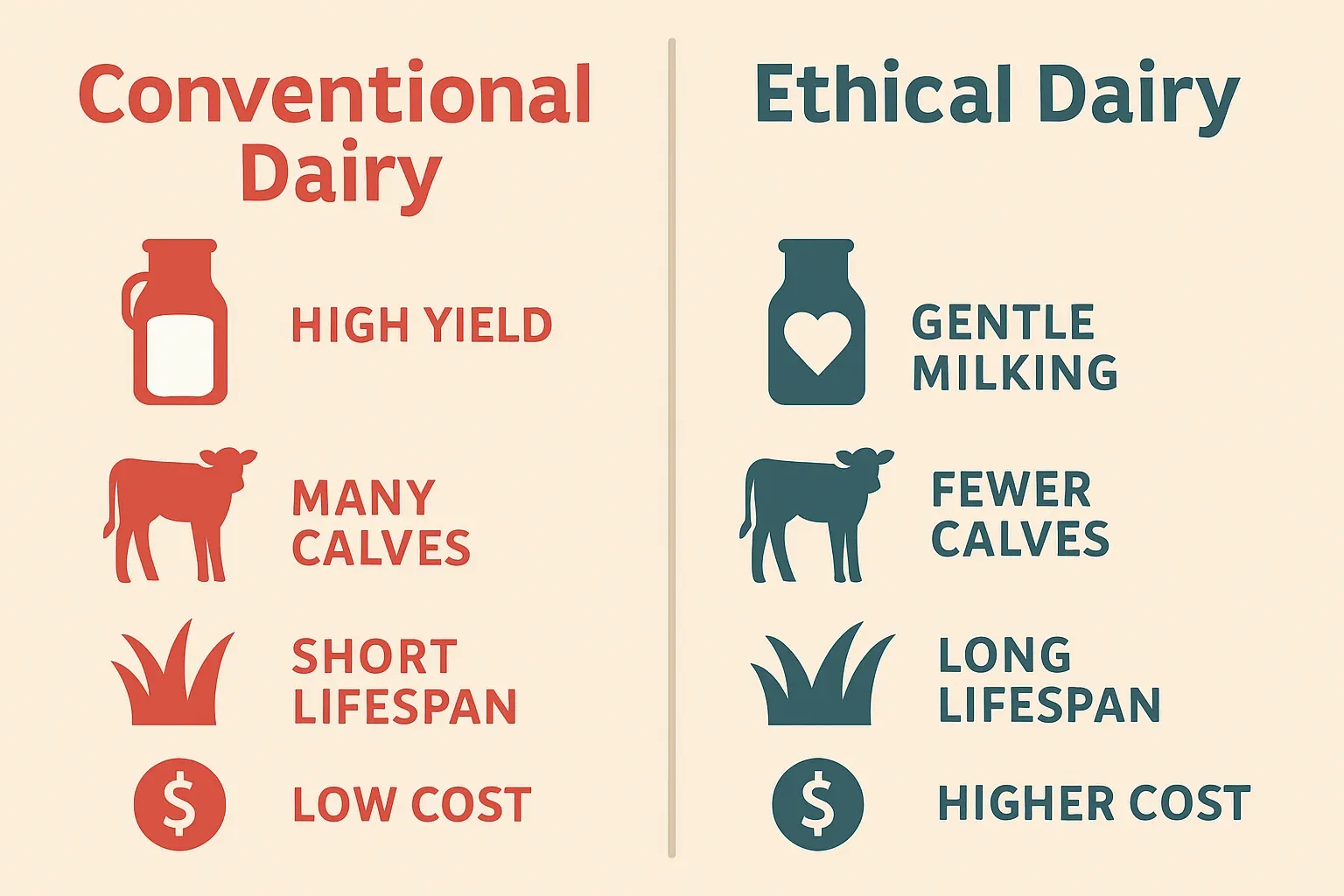
🧠 Final Thought: Milk with Morals
Cow’s milk is one of the most “normal” products in the world.
It’s also one of the most ethically awkward.
But the good news is that alternatives exist—and not just plant milk.
With the right genetics, management, and public support, we could reimagine dairy in a way that dramatically reduces suffering.
Just like we did with in-ovo sexing in the egg industry.[3:1][4:1]
So next time you pour a splash of milk in your tea, ask yourself:
“What kind of cow did this come from?”
Because the answer doesn’t have to be tragic.
It could be Milda.
Living her best life.
Still milking. Still mooing.
And still only had one baby.
Sources
van Knegsel, A.T.M., 2022. Extending lactation length: consequences for cow, calf, and farmer. Journal of Animal Science. https://pubmed.ncbi.nlm.nih.gov/35723261/. Accessed 16 August 2025. ↩︎ ↩︎ ↩︎ ↩︎
Creutzinger, K., Pempek, J., Habing, G., Proudfoot, K., Locke, S., Wilson, D., & Renaud, D., 2021. Perspectives on the Management of Surplus Dairy Calves in the United States and Canada. Frontiers in Veterinary Science 8:661453. https://doi.org/10.3389/fvets.2021.661453. Accessed 16 August 2025. ↩︎
Bundesgesetzblatt, 2021. Gesetz zur Änderung des Tierschutzgesetzes – Verbot des Kükentötens. BGBl. I 2021, Nr. 34, S. 1826. https://media.offenegesetze.de/bgbl1/2021/bgbl1_2021_34_original.pdf. Accessed 16 August 2025. ↩︎ ↩︎
Corion, M., et al., 2023. Trends in in ovo sexing technologies. Poultry-related review (open-access overview). National Library of Medicine (PMC). https://pmc.ncbi.nlm.nih.gov/articles/PMC10347793/. Accessed 16 August 2025. ↩︎ ↩︎
Stelwagen, K., et al., 2024. A review of extended lactation in dairy cows managed in high-input and pasture-based farming systems Animal Production Science 64: AN24167. https://doi.org/10.1071/AN24167. Accessed 16 August 2025. ↩︎ ↩︎ ↩︎
Njuki, E., Key, N., & Sneeringer, S., 2022. Sources, Trends, and Drivers of U.S. Dairy Productivity and Efficiency (ERR-305). USDA Economic Research Service. https://www.ers.usda.gov/sites/default/files/_laserfiche/publications/103301/ERR-305.pdf. Accessed 16 August 2025. ↩︎
Cole, J.B., & VanRaden, P.M., 2006. Genetic evaluation and best prediction of lactation persistency. Journal of Dairy Science 89(7):2722–2738. https://www.sciencedirect.com/science/article/pii/S0022030206723487. Accessed 16 August 2025. ↩︎ ↩︎ ↩︎
de Oliveira, H.R., Campos, G.S., Lazaro, S.F., Jamrozik, J., Schinckel, A., & Brito, L.F., 2024. Phenotypic and genomic modeling of lactation curves: A longitudinal perspective. JDS Communications 5(3):241–246. https://doi.org/10.3168/jdsc.2023-0460. Accessed 16 August 2025. ↩︎ ↩︎
Fotso-Kenmogne, P.R., et al., 2025. Genomic-based genetic parameters for daily milk yield and various lactation persistency traits in American Holstein cattle. Journal of Dairy Science 108(7):7329–7344. https://doi.org/10.3168/jds.2024-25836. Accessed 16 August 2025. ↩︎
Ahimsa Dairy Foundation, 2025. Slaughter-free milk (UK) — mission and practices. Ahimsa Milk. https://www.ahimsamilk.org/. Accessed 16 August 2025. ↩︎ ↩︎
Gita Nagari Creamery, 2025. Shop homepage — product catalog and pricing. https://shopgitanagari.com/. Accessed 16 August 2025. ↩︎ ↩︎
Hanssen, H., Amundsen, H., & Johnsen, J.F., 2024. Cow–calf contact: a single-herd observational study of AMS yield during the first 100 days in milk. Acta Veterinaria Scandinavica 66:33. https://doi.org/10.1186/s13028-024-00757-7. Accessed 16 August 2025. ↩︎
Han, R., Mourits, M., Steeneveld, W., & Hogeveen, H., 2022. The association of herd performance indicators with dairy cow longevity: An empirical study. PLOS ONE 17(12): e0278204. https://doi.org/10.1371/journal.pone.0278204. Accessed 16 August 2025. ↩︎
Vredenberg, I., Han, R., Mourits, M., Hogeveen, H., & Steeneveld, W., 2021. An Empirical Analysis on the Longevity of Dairy Cows in Relation to Economic Herd Performance. Frontiers in Veterinary Science 8:646672. https://doi.org/10.3389/fvets.2021.646672. Accessed 16 August 2025. ↩︎
Nosowitz, D., 2014. Slaughter-Free Milk: Will Customers Pay More to Put Cows Out to Pasture? Modern Farmer. https://modernfarmer.com/2014/06/slaughter-free-milk-will-customers-pay-more-to-put-cows-out-to-pasture/. Accessed 16 August 2025. ↩︎
Agriculture and Horticulture Development Board (AHDB), 2024. Great Britain leads the world in the uptake of sexed dairy semen. News (11 June 2024). https://ahdb.org.uk/news/great-britain-leads-the-world-in-the-uptake-of-sexed-dairy-semen. Accessed 16 August 2025. ↩︎
AHDB, 2024. Long-term trends in breeding choices on the dairy farm. Market Insight (16 May 2024). https://ahdb.org.uk/news/long-term-trends-in-breeding-choices-on-the-dairy-farm. Accessed 16 August 2025. ↩︎
AHDB, 2025. Beef market update: Beef from the dairy herd continued to bolster domestic supply in 2024. (12 March 2025). https://ahdb.org.uk/news/beef-market-update-beef-from-the-dairy-herd-continued-to-bolster-domestic-supply-in-2024. Accessed 16 August 2025. ↩︎
European Commission CORDIS, 2025. TransformDairyNet: Working together to upscale Cow–Calf Contact systems (Project 101133326). https://cordis.europa.eu/project/id/101133326. Accessed 16 August 2025. ↩︎


